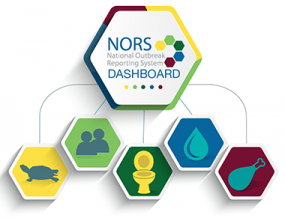Surveillance and Data Systems
CDC uses several surveillance systems to track foodborne, waterborne, and animal contact diseases reported in the United States. Most often, information in these systems comes from state and local health agencies. Although some of these systems have been used extensively for decades, new surveillance methods have improved the quality, quantity, and timeliness of their data. The surveillance systems described below play an important role in detecting and preventing disease and outbreaks.
Foodborne Disease Surveillance
Foodborne Disease Active Surveillance Network (FoodNet)
FoodNet conducts surveillance in ten U.S. sites for infections caused by eight pathogens transmitted commonly through food.
Foodborne Disease Outbreak Surveillance System (FDOSS)
FDOSS collects and reports national data on foodborne disease outbreaks, defined as the occurrence of two or more cases of a similar illness resulting from consuming a common food.
National Antimicrobial Resistance Monitoring System for Enteric Bacteria (NARMS)
NARMS is an interagency public health surveillance system that tracks antimicrobial resistance in foodborne and other enteric (intestinal) bacteria from humans (CDC), retail meats (FDA), and food animals (USDA) in the United States.
National Electronic Norovirus Outbreak Network (CaliciNet)
CaliciNet is a national laboratory network focused on norovirus, the leading cause of foodborne illness in the United States.
National Environmental Assessment Reporting System (NEARS)
NEARS is a surveillance system run by CDC’s National Center for Environmental Health that captures data to help identify the underlying environmental causes of foodborne illness outbreaks.
National Surveillance of Bacterial Foodborne Illnesses
CDC conducts national surveillance for illnesses caused by bacterial enteric pathogens, such as botulism and Shigella.
PulseNet
PulseNet is a national laboratory network that connects foodborne illness cases to detect outbreaks. PulseNet uses DNA fingerprinting of bacteria making people sick to detect thousands of local and multistate outbreaks.
CDC is creating an interactive dashboard to present foodborne surveillance data, including real-time data from PulseNet isolates. As an interim step, we will provide interim quarterly static reports of PulseNet data.
System for Enteric Disease Response, Investigation, and Coordination (SEDRIC)
CDC, state and local health departments, the U.S. Food and Drug Administration, and the U.S. Department of Agriculture Food Safety and Inspection Service use SEDRIC, a secure, web-based platform that combines epidemiologic, laboratory, and traceback data in real time, to collaborate when investigating multistate outbreaks.
Animal Contact Outbreak Surveillance
Animal Contact Outbreak Surveillance System (ACOSS)
ACOSS collects national data on outbreaks of human enteric illness linked to contact with animals or their environments.
Waterborne Disease Surveillance
CryptoNet
CryptoNet is a molecular tracking system that collects information on cryptosporidiosis (Crypto), the diarrheal disease caused by the parasite Cryptosporidium.
One Health Harmful Algal Bloom System (OHHABS)
OHHABS is a CDC reporting system that informs work to prevent people and animals from becoming sick from harmful algal blooms.
Waterborne Disease and Outbreak Surveillance System (WBDOSS)
WBDOSS collects data on waterborne disease and outbreaks associated with recreational water, drinking water, environmental, and undetermined water exposures.
Wastewater Surveillance
National Wastewater Surveillance System (NWSS)
NWSS is a new public health tool to understand COVID-19 spread in communities using wastewater data.
National Outbreak Reporting System
National Outbreak Reporting System (NORS)
NORS is a web-based platform that U.S. health departments use to report outbreak information to CDC. Through NORS, CDC collects reports of enteric disease outbreaks caused by bacterial, viral, parasitic, chemical, toxin, and unknown germs. NORS also collects reports of foodborne and waterborne disease outbreaks that are not enteric. NORS is managed by the National Center for Immunization and Respiratory Diseases.
